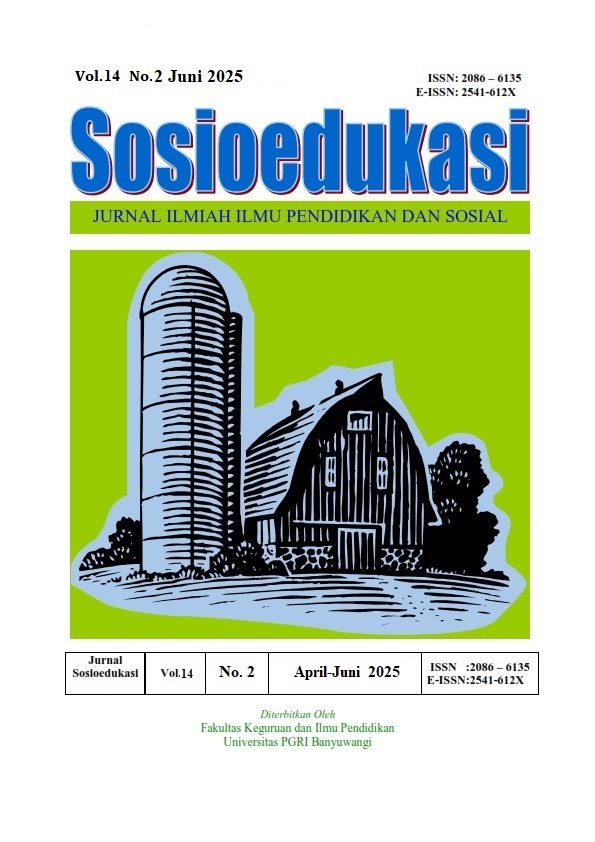DIGITAL MEDIA HABITS ACROSS GENERATIONS: A STUDY OF MEDIA
DOI:
https://doi.org/10.36526/sosioedukasi.v14i1.5681Keywords:
Media habits, smartphone, digital native, generational analysis, media convergenceAbstract
This study examines the media consumption habits of residents in Medan City, Indonesia, in response to the widespread adoption of smartphones and internet access. The research applies a quantitative descriptive approach using a survey of 400 respondents across generational categories (Baby Boomers, Gen X, Millennials, Gen Z, Alpha). Results reveal a dominant reliance on smartphones for accessing media content, with a declining trend in traditional television and radio use. Social media, particularly YouTube, WhatsApp, and Instagram, have become a primary source of information and entertainment, especially among young generations. The study employs uses and gratifications theory and media dependency to analyze generational differences in digital behavior. Findings indicate a significant generational shift toward mobile-centric and socially interactive media patterns, contributing to the understanding of digital audience behavior in an emerging urban context.
References
Anne Austin, J. B. (2016). Media Consumption Forecast 2016. Zenith.
Azogue, L. E., Descals, A. M., Romero, M. J., & Frasquet, M. (2022). Mobile dependency and uncertainty reduction: influence on showrooming behaviours and user-generated content creation. International Journal of Retail & Distribution Management, 50. https://doi.org/10.1108/IJRDM-10-2021-0487
Babbie, E. (2010). The Practice of Social Research. California: Wadsworth Cengage Learning.
Baran, S. J. (2012). Mass Communication Theory. Boston: Wadsworth Cengage Learning.
Dhir, A. (2015). On the Nature of Internet Addiction: What is it and How is it Measured? (Doctoral dissertation). Helsinky: Helsingin yliopisto.
Durak, H. Y. (2018). What Would You Do Without Your Smartphone? Adolescents’ Social Media Usage, Locus of Control, and Loneliness as a Predictor of Nomophobia. ADDICTA: The Turkish Journal on Addictions, 1-15.
Friedrichsen, M. (2012). Digital Transformation in Journalism and News Media; Media Management, Media Convergence, and Globalization. New York: Springer.
Galen Stocking, P. V. (2020). Many Americans Get News on YouTube, Where News Organizations and Independent Producers Thrive Side by Side. Pew Research Center.
Gan, C. (2017). Understanding WeChat users’ liking behavior: an empirical study in China. Computers in Human Behaviour, 68, 30-39. https://doi.org/10.1016/j.chb.2016.11.002
Ha, L., Xu, Y., & Yang, C. (2016). Decline in news content engagement or news medium engagement? A longitudinal analysis of news engagement since the rise of social and mobile media 2009–2012. Journalism, 19(5), 718-739. https://doi.org/10.1177/1464884916667654
Hilmes, M. (2020). The Television History Book. London: The British Film Institute.
Jatmiko, Leo Dwi. (2019, Mei 19). Kecepatan Akses Data di Kota Besar, Medan Paling Ngebut. Retrieved from https://teknologi.bisnis.com/read/20190510/101/920960/kecepatan-akses-data-di-kota-besar-medan-paling-ngebut
Jenkins, H. (2006). Convergence Culture: Where Old and New Media Collide. New York: NYU Press.
Kanyeki, J. W. (2017). Overcoming Convergence in East Africa’s Media Houses: The Case of the Standard Media Group. New York: Springer.
Kristen Bialik, K. E. (2017). Key Trends In Social And Digital News Media. Pew Research Center.
Li, Y., Yang, S., Zhang, S., & Zang, W. (2019). Mobile Social Media Use Intention In Emergencies Among Gen Y In China: An Integrative Framework Of Gratifications, Task-Technology Fit, And Media Dependency. Telematics and Informatic, 42, 101244. https://doi.org/10.1016/j.tele.2019.101244
Linden, T., Nwaz, S., & Mitchell, M. (2021). Adults’ Perspectives On Smartphone Usage And Dependency In Australia. Computers in Human Behaviour Reports, 3, 1-9. https://doi.org/10.1016/j.chbr.2021.100060
Littlejohn. (2009). Encyclopedia of Communication Theory. California: Sage Publications.
Lugmayr, A. (2016). Media Convergence Handbook - Vol 1, Journalism, Broadcasting, and Social Media Aspect of Convergence. New York: Springer.
Lyu, J. C. (2019). Has the Internet Won the Hearts of Chinese College Students? A Comparative and Communication Medium Dependency Approach. China Media Research, 15(2), 91-101.
Nasib, S. (2021). Motive Uses and Gratification Platform E-Traveling Traveloka. International Journal of Humanities, Arts and Social Sciences, 7(1), 46-57. https://dx.doi.org/10.20469/ijhss.7.20005-1
Rohrs, J. K. (2014). Audience; Marketing in The Age of Subscribers, Fans, & Followers. New Jersey: Wiley.
Saeed, M. (2021). Exploring News Media Usage Among University Students to Fulfil Needs: Uses & Gratification Perspective. Human Nature Journal of Social Science, 12(01), 29-41.
Schnauber-Stockman, T. N. (2016). Habitual Initiation of Media Use and a Response-Frequency Measure for Its Examination. Media Psychology, 19, 125-155. https://doi.org/10.1080/15213269.2014.951055
Shreesha Mairaru, S. T. (2019). Understanding the Print, Web, Television Media Habits and Preferences of. Journal of Content, Community & Communication, 75-80.
Singh, P. (2020). Dependency: Digital Media & Print Media. Journal of University of Shanghai for Science and Technology, 22(10), 1296-1305.
Suryanto, T. L., Wibowo, N. C., Ithiriah, S. A., Faroqi, A., & Fatkhur, D. (2018). Why Indonesian Users Visiting Youtube An Exploration Of Uses And Gratification Theory. International Joint Conference on Science and Technology, (pp. 512-518). Bali.
Walker, M. (2019). Americans Favor Mobile Devices Over Desktops And Laptops For Getting News. Pew Research Center.
Weiyan, L. (2015). A Historical Overview of Uses and Gratifications Theory. Cross-Cultural Communication, 11(9), 71-78. http://dx.doi.org/10.3968/%25x
West, R. (2014). Introducing Communication Theory; Analysis and Application. USA: Mc Graw Hill.









.png)

















